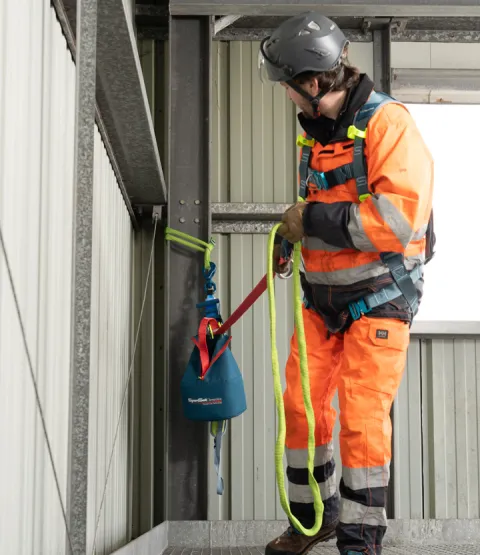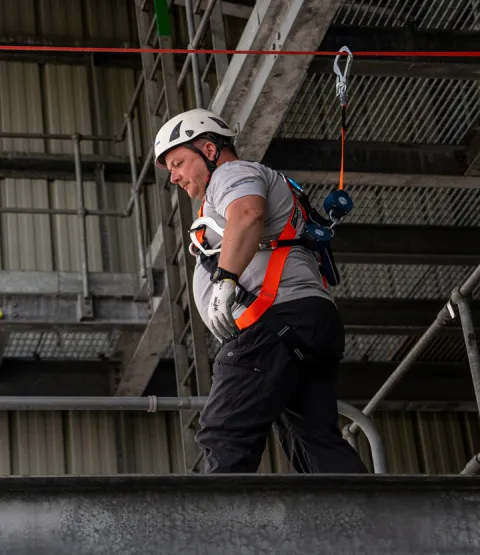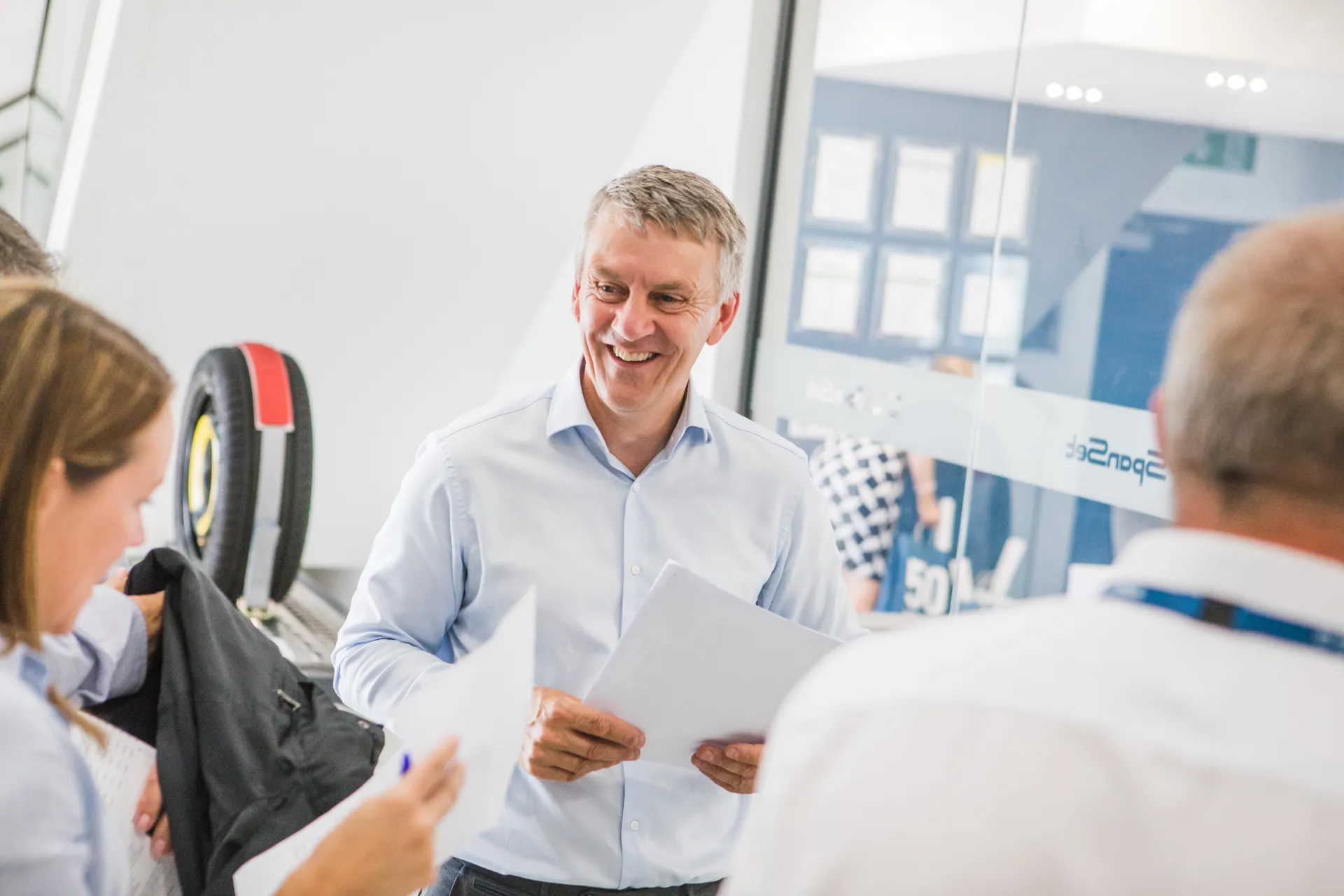In many cases, with careful planning and organisation it is possible to work at height and completely avoid getting too close to, or exposed to, edges where a fall can occur.
However, it is not always possible to avoid fall hazards. Fortunately, due to the development of Personal Fall Protection Equipment (PFPE) and correct training in its use, the era of workers having to carry out tasks at height, with little or no protection has passed.
Utilising Work Restraint equipment and techniques, whereby the areas a worker can move and work in are restricted - by means of PFPE - to keep them safe, can be an effective way to prevent a fall occurring.
The issue for Work Restraint, as with all Personal measures, is ensuring that the person using them understands the key principles to make the most of the benefits of this method of work. They also need to be supported by supervisors or managers who ensure the system remains effective and can even be refined as work progresses.
This requires clear assessment of the work task, identifying where avoidance can reduce risk and when PFPE is needed. Managers as well as those carrying out the task will benefit from Training and it is always worth considering consultancy advice, especially if looking for a solution to use repeatedly.
Fall Arrest Equipment and Techniques are often relied on for getting to or from the workplace and when carrying out tasks close to fall hazards.
Unlike Avoidance and Work Restraint, Fall Arrest equipment and Techniques allow a fall to occur and then deal with the consequences, catching the worker in a controlled manner.
In the early days of Fall Arrest, producing equipment to catch a falling worker was challenging, however modern design and materials have improved things significantly.
The challenges of fall arrest are dictated by the choice of anchor point available and the freedom of movement the worker requires.
Anchors should ideally be above head height and the attachment to them as short as possible, virtually eliminating the fall. Where anchor points are lower and the attachment includes some slack to allow freedom to work then, should a fall occur, it will be bigger and the equipment will have to work harder. To address this, it is now possible to choose how quickly or slowly the fall is arrested by applying more aggressive or softer braking forces. These innovations not only increase the areas where Fall Arrest can be used, but also who can use it - Heavier people previously would have found it difficult to source equipment capable of dealing with the energy they could create during a large fall as standards were based around people only weighing up to 100kg.
The use of more aggressive braking forces means it is now possible to arrest falls of heavier users in shorter distances providing them protection within standards set out previously for lighter people. Surely the maximum fall distance should be for everyone?
However, this causes problems - if that same, more aggressive braking force is applied to a lighter person, then they will come to a stop far sooner and may be injured by the increased G-Force applied to them by the safety equipment itself.
Recent discussions in standards committees are starting to look more closely at this. Their focus however is on equipment performance to provide different arrest forces for different user masses - but this assumes a falling worker has plenty of free space below them, something any person working on site knows is rare.

Setting up a temporary anchor point for the attachment of fall arrest or work positioning/restraint systems.
Diagrams in test standards or technical documents never include obstructions in the fall zone – are equipment designers designing for these diagrams or real-life situations?
We believe the following:
- If a fall occurs, the further the person is allowed to fall before it is arrested the more likely they are to be injured by colliding with obstacles.
- For most people collisions with obstacles during a fall are likely to pose the biggest risk.
- A propensity for standards to focus on braking forces and user masses is likely to result in equipment addressing the wrong issues and not relate to the realities workers experience daily.
- Fall Arrest equipment should be designed to reduce the initial free fall distance before braking occurs as much as possible. This in turn means the brakes have less work to do and the braking distance is also reduced.
- If done well the overall fall will be far shorter and the likelihood of collisions significantly reduced.
Significant reductions in the combined freefall and arrest distance are available now. Industry does not need to wait for changes to the standards, equipment simply needs to be designed for the real-life situations workers find themselves in today.
This is currently SpanSet’s focus - concentrating on shorter attachments where possible, equipment that reacts sooner with braking forces applied consistently and at the optimum forces - keeping fall distances to a minimum.
There are other benefits of keeping falls smaller - rescue and recovery becomes easier and, in some cases, it will be possible for the faller to get back to safety on their own.
In all cases when using Fall Arrest, equipment and techniques rescue must be planned for as the fall and subsequent arrest both provide opportunity for injury.
These days, a wide range of Rescue kits are available to industry, essential as there are many different potential rescue scenarios. Having a specifically designed rescue kit helps to take the worry out of what can be a stressful time for the workforce, as of course does regular Rescue Training. The combination of a good rescue kit and proficient staff means that casualty management can become the top priority - taking the drama out of a crisis.

Above/main image - Keeping fall distances to a minimum with the use of a Dynamic Self-Retracting lanyard.
A wolf in sheep’s clothing? An example of a product’s feature working against the equipment’s real function.
For situations where PFPE is required the first decision for most is which harness to choose - the range available can be overwhelming. Cost will always be a consideration, as will technical features however comfort will often dictate if a particular harness is accepted by the workforce - so is elastication the answer?
A correctly adjusted harness should have a small amount of slack in it to be comfortable and allow for freedom of movement. However, and most importantly, not too much slack so that, in the event of a fall the harness provides the correct level of support. If elastication is included in a harness it will have to be worn tightly, without any slack to ensure it still provides the right level of support when stretched by the wearer’s weight in the event of a fall. Therefore, a properly adjusted harness without elastication is likely to be far comfier and more effective when asked to perform, saving and supporting the wearer.

Above - A well-designed and properly adjusted harness will allow for freeedom of movement and the proper level of support in the event of a fall.
"In the modern workplace the provision of equipment and training to address those real-life situations, protecting us when we need it most, whilst also meeting or exceeding the standards should be a basic right. Believing the level a product should aspire to is a standard created many years ago, is certainly not my idea of innovation, designing products and services that recognise a person’s working at height reality is.
Here’s to investment in innovation and product performance to ensure no one pays the price of poor design."
Pete Ward, MD SpanSet UK
